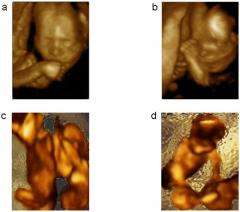October 13, 2010 report
Twin fetuses learn how to be social in the womb

(PhysOrg.com) -- Humans have a deep-seated urge to be social, and new research on the interactions of twins in the womb suggests this begins even before babies are born.
Researchers from the University of Padova in Italy have been studying pregnancies involving twins. Leader of the team, psychologist Umberto Castiello, explained that newborns appear to be already "wired" to interact socially with other humans soon after birth, and previous research has demonstrated that within only a few hours after birth babies can imitate gestures of people around them and make other social interactions. Studying twins in the womb made it possible to see investigate the pre-wired hypothesis and see if socialization was already apparent while still in the womb.
The study, which was published in the Public Library of Science One (PLoS One), used four-dimensional ultrasonography to make 3D videos of twins at 14 and 18 weeks of gestation. The five pairs of twins were found to be reaching for each other even at 14 weeks, and making a range of contacts including head to head, arm to head and head to arm. By the time they were at 18 weeks, they touched each other more often than they touched their own bodies, spending up to 30 percent of their time reaching out and stroking their co-twin.
The ultrasound technique the researchers used allowed them to change the depth of visual field, the frame rate, and the sweep angle. The twin fetuses were taped for 20 minutes each time, and the video recordings were digitzed for offline analysis of the hand movements.
Kinematic analyses of the recordings showed the fetuses made distinct gestures when touching each other, and movements lasted longer — their hands lingered. They also took as much care when touching their twin’s delicate eye region as they did with their own. This type of contact was not the same as the inevitable contact between two bodies sharing a confined space or accidental contacts between the bodies and the walls of the uterus, and there was no increase in the frequency in these types of contacts in the four weeks.
The findings clearly demonstrate it is deep within human nature to reach out to other people.
More information: Wired to Be Social: The Ontogeny of Human Interaction, Umberto Castiello et al., PLoS ONE 5(10): e13199. doi:10.1371/journal.pone.0013199
© 2010 PhysOrg.com













